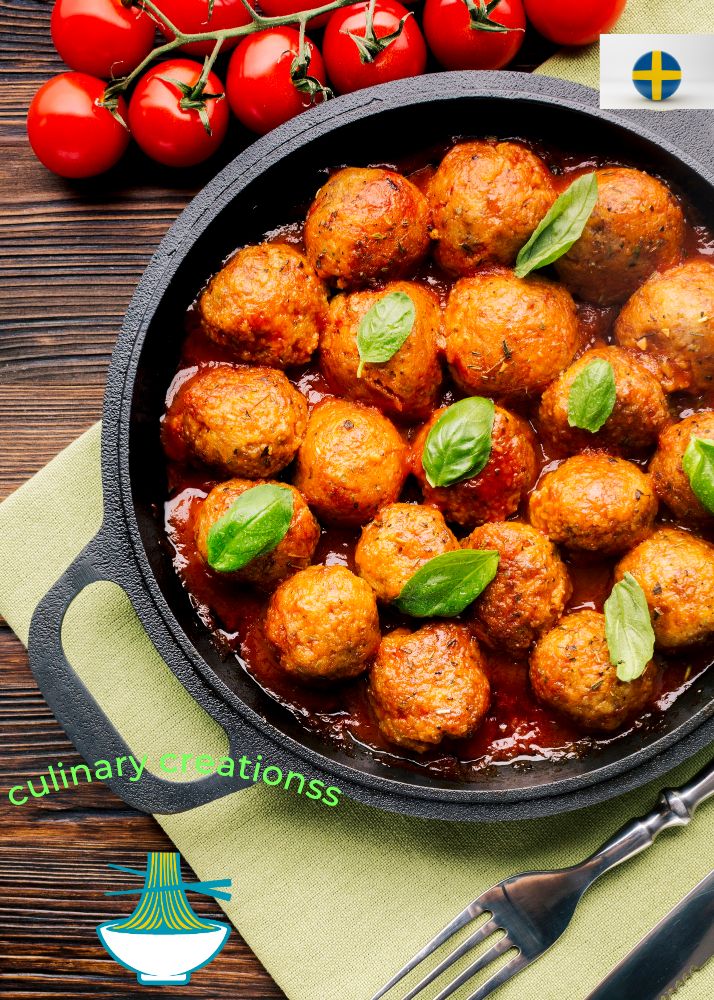A Deep Dive into Swedish Meatballs: A Culinary Journey
Related Articles
- The Samosa: A Culinary Journey Through Time And Taste
- A Spicy Journey: Exploring The World Of Sichuan Hot Pot
- A Journey Through The Delicate World Of Macarons (French)
- A Slice Of History: The Evolution Of Pizza In Italy
- A Journey Through The World Of Couscous: A Maghribi Culinary Adventure
Introduction
Welcome to our in-depth look at A Deep Dive into Swedish Meatballs: A Culinary Journey
A Deep Dive into Swedish Meatballs: A Culinary Journey

Swedish meatballs, those iconic little spheres of savory goodness, are a beloved dish around the world. They’re not just a delicious meal, but a cultural icon, representing a comforting simplicity and a celebration of hearty flavors. But beyond the simple image of a meatball bathed in creamy gravy, lies a rich history and a world of culinary possibilities.
This article will take you on a journey through the fascinating world of Swedish meatballs, exploring their origins, the evolution of their preparation, and the diverse ways they can be enjoyed. We’ll delve into the nuances of ingredients, the secrets to achieving perfect texture, and the art of crafting delicious variations, all while maintaining a casual yet informative tone. Get ready to learn the secrets of these little culinary gems, and discover why they’ve captured the hearts (and stomachs) of generations.
A Bite of History: The Roots of Swedish Meatballs
The origins of Swedish meatballs are shrouded in the mists of time, with their history intertwined with the evolution of Swedish cuisine. The earliest known mentions of meatballs in Sweden date back to the 18th century, but it’s likely they existed long before that, perhaps as a peasant dish made with readily available ingredients.
The concept of meatball-like dishes is universal, with variations appearing across cultures and continents. From the "kötbullar" (meatballs) of Scandinavia to the "albóndigas" of Spain, the concept of ground meat rolled into bite-sized portions and cooked in various sauces has transcended borders and time.
The influence of neighboring cultures: Swedish cuisine has always been influenced by its neighbors, and this is evident in the evolution of meatballs. The rich history of trade with Germany and the Baltic states introduced new ingredients and cooking techniques, enriching the culinary landscape of Sweden.
The rise of the modern Swedish meatball: While the basic concept of meatballs has been around for centuries, the modern version we know and love today emerged in the late 19th and early 20th centuries. This coincided with the rise of industrialization and urbanization in Sweden, leading to a need for quick and affordable meals. Meatballs, with their versatility and ability to be made in large quantities, became a popular choice for families and restaurants alike.
Understanding the Ingredients: The Building Blocks of Flavor
Swedish meatballs are a symphony of flavors, each ingredient playing a crucial role in creating the harmonious whole. Let’s break down the key players:
1. The Meat: Traditionally, Swedish meatballs are made with a blend of ground pork and beef, often with the addition of veal. The ratio of meat can vary, with some recipes using a 50/50 blend, while others lean towards a more pork-heavy mix.

- Pork: Provides a rich, savory flavor and a slightly fatty texture that contributes to juiciness.
- Beef: Adds a leaner texture and a robust, meaty flavor.
- Veal: Offers a delicate, mild flavor and a tender texture.
2. The Binder: The binder is essential for holding the meatballs together and ensuring they maintain their shape during cooking.
- Breadcrumbs: The most common binder, adding texture and moisture.
- Milk or Cream: Soaked into the breadcrumbs, adds moisture and helps create a smooth, cohesive texture.
- Egg: Acts as a natural binder and adds richness.
3. The Aromatics: These ingredients infuse the meatballs with complex flavors and aromas.
- Onion: Adds sweetness and depth to the flavor profile.
- Garlic: Provides a pungent, earthy note.
- Allspice: A unique spice blend common in Swedish cuisine, adding warmth and complexity.
- Salt and Pepper: Essential for seasoning and balancing flavors.

4. The Sauce: The creamy gravy that accompanies Swedish meatballs is just as crucial as the meatballs themselves. It provides a rich, comforting backdrop for the savory flavors.
- Butter: Adds richness and a smooth texture.
- Flour: Thicken the sauce and creates a velvety consistency.
- Beef Broth: Provides depth of flavor and a savory base for the sauce.
- Cream: Adds richness and a smooth, creamy texture.
- Soy Sauce: Provides a subtle umami note and balances the sweetness of the sauce.
Mastering the Technique: From Dough to Dish
Creating perfect Swedish meatballs is a blend of art and science. It’s about understanding the interplay of ingredients, mastering the techniques, and embracing the nuances of flavor. Here’s a breakdown of the key steps:
1. Preparing the Meat Mixture:
- Choosing the Right Meat: Opt for fresh, high-quality ground meat for the best flavor and texture.
- Mixing and Kneading: Gently combine the ground meat, binder, and aromatics. Avoid over-mixing, as it can toughen the meatballs.
- Chilling the Meat: Refrigerate the meat mixture for at least 30 minutes to allow the flavors to meld and the binder to absorb moisture.
2. Shaping the Meatballs:
- Consistent Size: Aim for meatballs that are about the size of a large walnut. This ensures even cooking and a consistent bite.
- Rolling Technique: Gently roll the meat mixture into balls, using your hands or a small spoon.
- Tightly Packed: Ensure the meatballs are tightly packed, preventing them from falling apart during cooking.
3. Cooking the Meatballs:
- Pan-Frying: This is the most common method for cooking Swedish meatballs. Heat a pan with oil over medium heat and cook the meatballs until golden brown on all sides.
- Baking: Preheat your oven to 375°F (190°C). Arrange the meatballs on a baking sheet lined with parchment paper and bake for 15-20 minutes, or until cooked through.
- Slow Cooking: Place the meatballs in a slow cooker with the sauce ingredients and cook on low for 4-6 hours. This method produces tender, flavorful meatballs.
4. Making the Creamy Sauce:
- Sautéing the Butter and Flour: In a separate pan, melt butter and whisk in flour to create a roux. This will thicken the sauce.
- Adding the Broth: Gradually whisk in beef broth, ensuring the sauce is smooth and lump-free.
- Simmering the Sauce: Bring the sauce to a simmer and cook for a few minutes, allowing the flavors to meld.
- Incorporating the Cream: Stir in cream and soy sauce, adjusting the seasoning to taste.
5. Combining the Meatballs and Sauce:
- Adding the Meatballs: Gently add the cooked meatballs to the sauce, ensuring they are fully submerged.
- Simmering Together: Simmer the meatballs in the sauce for a few minutes to allow them to absorb the flavors.
The Art of Variation: Exploring the World of Swedish Meatball Recipes
While the traditional Swedish meatball recipe is a classic, there’s endless room for culinary exploration. Experiment with different ingredients, cooking techniques, and flavor profiles to create your own unique variations.
1. Playing with Meat Combinations:
- Ground Chicken or Turkey: For a lighter and leaner option, substitute ground chicken or turkey for the traditional pork and beef blend.
- Lamb: Add a distinct, savory flavor to your meatballs by incorporating ground lamb.
- Seafood: For a unique twist, experiment with ground fish or shellfish, creating Swedish meatballs with a maritime flair.
2. Embracing Flavorful Additions:
- Fresh Herbs: Incorporate fresh herbs like parsley, dill, or chives to add a burst of freshness to the meatballs.
- Spices: Experiment with spices like cumin, coriander, or ginger to add depth and complexity to the flavor profile.
- Vegetables: Chop and mix in finely diced vegetables like carrots, celery, or mushrooms for added nutrition and flavor.
3. Tweaking the Sauce:
- Lemon Juice: Add a touch of brightness and acidity to the sauce with a squeeze of lemon juice.
- Wine: Incorporate white or red wine to the sauce for a more complex and sophisticated flavor.
- Mushrooms: Sauté mushrooms in the sauce for a rich, earthy flavor and a textural element.
4. Serving Suggestions:
- Classic Accompaniments: Serve Swedish meatballs with mashed potatoes, creamy gravy, and lingonberry sauce for a traditional experience.
- Contemporary Sides: Pair meatballs with quinoa, roasted vegetables, or a green salad for a lighter and more modern take.
- Global Influences: Explore global flavors by serving Swedish meatballs with Asian-inspired sauces, rice noodles, or couscous.
Culinary Tips and Tricks: Elevating Your Meatball Game
To ensure your Swedish meatballs are a culinary triumph, here are some valuable tips and tricks:
1. Don’t Overwork the Meat: Over-mixing the meat mixture can lead to tough meatballs. Gently combine the ingredients, ensuring the binder is evenly distributed.
2. Chill the Meat Mixture: Refrigerating the meat mixture for at least 30 minutes allows the flavors to meld and the binder to absorb moisture, resulting in more cohesive meatballs.
3. Use a Thermometer: Ensure the meatballs are cooked through by using a meat thermometer to check the internal temperature. They should reach at least 160°F (71°C).
4. Control the Heat: Cook the meatballs over medium heat to ensure they brown evenly without burning.
5. Don’t Overcrowd the Pan: Avoid overcrowding the pan when pan-frying the meatballs. This allows them to cook evenly and develop a beautiful golden brown crust.
6. Adjust the Sauce Consistency: The sauce should be thick enough to coat the meatballs but not too thick to become gloppy. Add more broth or cream as needed to achieve the desired consistency.
7. Season to Taste: Taste the sauce and adjust the seasoning accordingly. Remember, it’s better to add more salt and pepper gradually than to over-season.
8. Enjoy the Process: Cooking Swedish meatballs is a journey of flavors and textures. Embrace the process, experiment with different variations, and enjoy the satisfaction of creating a delicious and comforting dish.
Conclusion: A Culinary Legacy Lives On
Swedish meatballs are more than just a dish; they are a culinary legacy that spans generations, a testament to the enduring power of simple, wholesome flavors. From the humble beginnings of a peasant dish to the beloved classic it is today, Swedish meatballs have captured hearts and stomachs around the world.
This article has provided a comprehensive exploration of the world of Swedish meatballs, from their history and ingredients to the techniques and variations that make them so captivating. We’ve delved into the secrets of achieving perfect texture, the art of crafting unique flavors, and the joy of sharing this culinary treasure with loved ones.
So, whether you’re a seasoned chef or a culinary novice, the world of Swedish meatballs awaits. Embrace the journey, explore the possibilities, and discover the magic of these little culinary gems.
Closure
We hope this article has helped you understand everything about A Deep Dive into Swedish Meatballs: A Culinary Journey. Stay tuned for more updates!
Make sure to follow us for more exciting news and reviews.
Feel free to share your experience with A Deep Dive into Swedish Meatballs: A Culinary Journey in the comment section.
Keep visiting our website for the latest trends and reviews.






